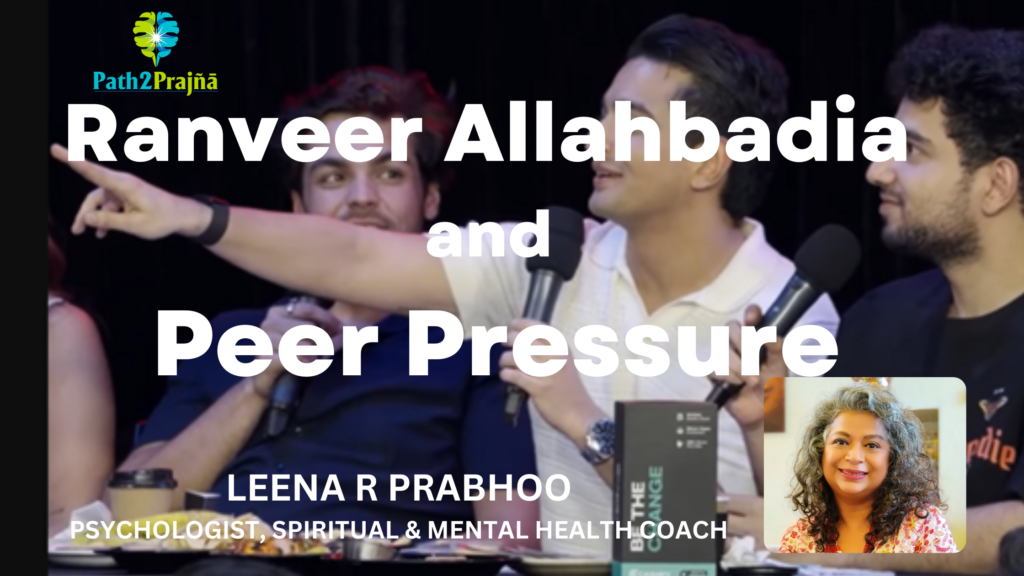Peer Pressure & Public Figures: The Ranveer Allahbadia Controversy Explained
Ranveer Allahbadia’s Controversy in Brief
Ranveer Allahbadia, a well-known Indian YouTuber and motivational speaker, faced massive backlash after making an inappropriate remark on the YouTube show India’s Got Latent. His question, deemed offensive, led to multiple police complaints and a parliamentary discussion on social media regulations.
Understanding Peer Pressure in Public Life
Peer pressure is a powerful psychological and social force that influences decision-making at all stages of life. For public figures, the impact is magnified due to constant scrutiny, audience expectations, and industry norms. Allahbadia’s case highlights how peer pressure can manifest in entertainment and digital media.
Key Factors Influencing Peer Pressure in Public Figures
- Show Format and Audience Expectations
- India’s Got Latent thrives on edgy humor. The pressure to match the show’s tone and keep viewers engaged might have influenced Allahbadia’s remark.
- Influence of Co-Participants
- The presence of other influencers, such as Ashish Chanchlani, Jaspreet Singh, and Apoorva Mukhija, could have created an unspoken expectation to contribute equally provocative content.
- Industry Norms and Digital Culture
- Shock value often drives engagement on social media. Content creators may feel compelled to push boundaries to stay relevant.
Broader Implications of Peer Pressure
Across Different Life Stages
- Children (Ages 5–12)
- Pressure to fit in through clothing, food choices, and schoolyard behavior.
- Example: A child may feel forced to participate in bullying or exclude a peer from a group to avoid being targeted themselves.
- Teenagers (Ages 13–18)
- Influence on substance use, relationships, and body image due to social validation needs.
- Example: A teen may start drinking or using drugs at parties to avoid feeling like an outsider, leading to potential addiction or harmful consequences.
- Example: Many teenagers feel pressured to enter relationships or engage in sexual activities to match their peers’ experiences. Fear of being labeled as inexperienced or left out can lead them to make choices they are not emotionally prepared for, sometimes resulting in emotional distress or risky behaviors.
- Example: Peer pressure can also lead teens to engage in sexting or sharing explicit images due to perceived expectations in romantic relationships. This can have serious legal and emotional consequences, including privacy violations and long-term psychological distress.
- Young Adults (Ages 19–29)
- Workplace culture, social media pressures, and financial decisions shaped by peer comparisons.
- Example: A young professional may take on excessive debt to maintain a luxurious lifestyle seen on social media, leading to financial stress and instability.
- Adults (Ages 30 and Above)
- Parenting styles, career expectations, and lifestyle choices are influenced by societal benchmarks.
- Example: A parent may enroll their child in expensive extracurricular activities despite financial strain, simply because others in their social circle are doing so.
Learning to Navigate Peer Pressure
Recognizing and managing peer pressure is crucial for personal and professional well-being. Strategies include:
- Self-awareness: Understanding personal values vs. external influence.
- Assertiveness: Learning to say no to pressures that don’t align with one’s beliefs.
- Selective Influence: Surrounding oneself with positive role models.
- Critical Thinking: Evaluating consequences before making decisions influenced by peer pressure.
- Building Confidence: Strengthening self-esteem to resist external pressures.
- Seeking Support: Talking to mentors, friends, or professionals when facing difficult social expectations.
- Setting Boundaries: Establishing clear limits on what one is willing to do despite peer influence.
- Media Literacy: Understanding how digital content and social media trends shape perceptions and learning to question narratives.
- Practicing Mindfulness: Using mindfulness techniques to stay grounded and make conscious decisions.
- Role-Playing Scenarios: Practicing responses to peer pressure situations to build resilience and confidence.
Conclusion
The Ranveer Allahbadia incident is a stark reminder of how peer pressure, even among public figures, can lead to misjudgments. Whether in entertainment, social circles, or professional environments, understanding and resisting undue influence is key to maintaining authenticity and responsible decision-making.
Further Reading & Resources
For deeper insights into peer pressure and social influence, explore these resources:
- Psychology Today – The Science of Peer Pressure
- Harvard Business Review – Social Influence and Decision-Making
- BBC – The Role of Social Media in Influencing Behavior
- The Guardian – When Public Figures Face Backlash Due to Social Influence
- American Psychological Association – Managing Social Influence
- Verywell Mind – How to Resist Peer Pressure
#PeerPressure #RanveerAllahbadia #SocialMediaInfluence #PublicFigures #EntertainmentIndustry #TeenInfluence #DigitalCulture #Psychology #SocialValidation

Amazon #1 Bestselling Author, Prajñā Strategist, Spiritual & Mental Health Coach, Recipient of TOP 100 HEALTHCARE LEADERS AWARD (DUBAI), Prajñā Strategist, Spiritual & Mental Health Coach, Certified Past Life Regression Therapist, Certified Telepathic Communicator & International Speaker
Over the last 30 years, I have been helping people get on to their Path to Prajñā so that they can skillfully & effectively handle “Challenges” which Life throws at them. I Coach people to Navigate Life Skillfully to Live Life Successfully so that you can Be What you CAN be. Grab your copy of my Amazon #1 Bestselling book My Path to Prajñā https://www.amazon.in/My-Path-Prajna-Leena-Prabhoo/dp/1635354544/

